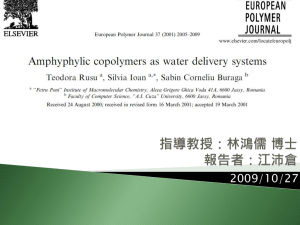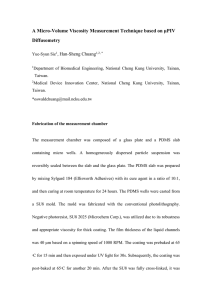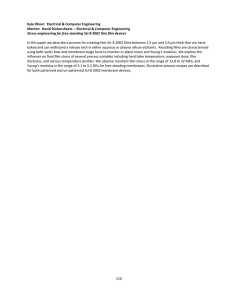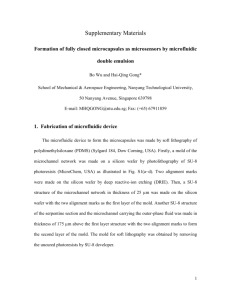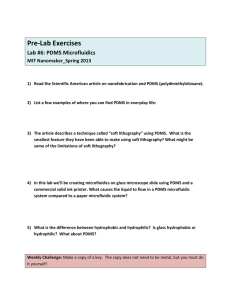Soft-lithographic methods for the fabrication of dielectrophoretic devices using molds by
advertisement
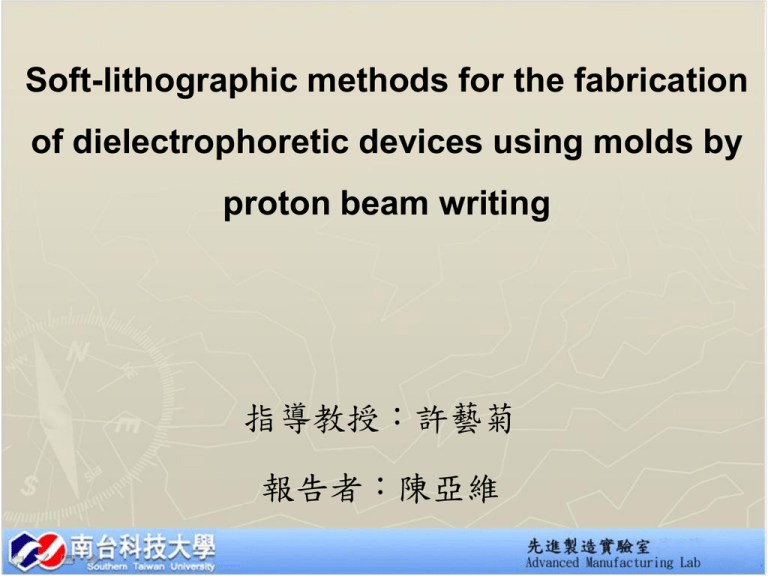
Soft-lithographic methods for the fabrication of dielectrophoretic devices using molds by proton beam writing 指導教授:許藝菊 報告者:陳亞維 Introduction Experiments Results and discussion Conclusions Keywords Soft-lithographic:透過多次翻模、轉移之技術來製 造出微米以及奈米的結構 PBW:利用MeV能量的聚焦質子束對材料直接刻寫 微奈米尺度微結構 Replica molding:利用PDMS灌注在母模上,待固化 後即可得到與母模相對應結構 SU-8:負光阻,化學、熱穩定性高,高穿透性, 以及有良好的結構體之厚度以及深寬比 Poly-dimethylsiloxane (PDMS) : 為目前生醫微機電系統(Bio-MEMS)常使用的材料 低溫下依然具有柔軟、彈性與可塑性 Introduction In this paper, soft-lithographic methods for the fabrication of 3D-DEP devices equipped with highaspect-ratio pillars, combined with a PDMS micro-fluidic channel replicated from a SU-8 mold fabricated by PBW Experiments PBW of SU-8 layer on silica for patterning pillar arrays and a mold for a micro-fluidic channel Soft ithography of micro-fluidic channel by the SU-8 mold Sealing the pillar arrays on silica with the PDMS, where the silica substrate with pillar arrays is bonded to PDMS with a micro-fluidic channel Results and discussion Fig. 3a shows a SEM image of the part of pillar arrays with an area of 1.0 mm 80 µm by PBW onto a 15µm thick SU8 on a silica substrate High-aspect-ratio pillars (rectangular of 2.5x6.8 µm in shape and 13 µm in height) were observed with smooth and vertical surface, as shown in Fig. 3b. Fig. 4a shows the SEM image of a SU-8 mold with 200 µm in width and 2.0 mm in length and 20 µm in height. Following the process illustrated in Fig. 1b, the pattern of the SU-8 mold was successfully transferred to PDMS, as shown in Fig. 4b. From an optical microscope image in Fig. 5a Fig. 5b shows a photograph of the DEP device with tubing at inlet and outlet ports. Thanks to the plasma treatment, the tight sealing was achieved and no leakage was observed. Fig. 6a shows a SEM image of a SU-8 mold with arrays of holes with rectangle of 7.0 X 5.3 µm^2 in shape and 12 µm in depth. As shown in Fig. 6b, the holes were successfully replicated to PDMS as arrays of pillars. important to lower the adhesion force between the SU-8 mold and PDMS and alignment of vertical direction during separation to avoid fracture of PDMS replica, Conclusions A soft lithography technique combined with PBW was successfully applied to the fabrication of the 3D-DEP device equipped with highaspect-ratio channel. pillar arrays in micro-fluidic The most critical part of the process is pattern transfer of the high-aspect pillar from the SU-8 mold to PDMS. Replication of relatively low-aspect-ratio pillar arrays was successful. Trials of successful replication of both pillar arrays and a micro-fluidic channel are underway for DEP devices with more complex structures. Thank you for your attention !
